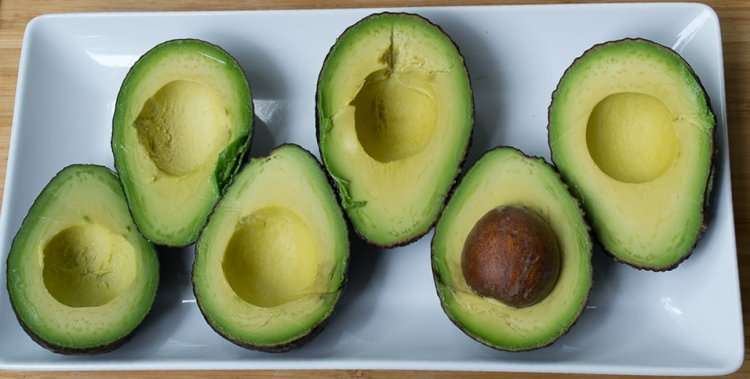Avocados do not grow in Vermont.
You may be able to convince the occasional seed to sprout (balanced on toothpicks, in a jar, on a sunny windowsill), but you’re not—believe me—going to get the wherewithal to make your own guacamole. Avocados know a waste of time when they see it. Besides, they’ve got enough trouble without taking on an uncongenial climate. Avocados have outpaced their evolutionary niche, which leaves them with a tough row to hoe.
Avocados originated in Mexico, where they were being cultivated as early as 5,000 BCE. The Spanish conquistadors were impressed with them, and Spanish historian Gonzalo Fernandez de Oviedo, in his 1526 General History of the Indies—the book that introduced Europeans to the pineapple, the hammock, tobacco, and barbecue—described the avocado as having a seed like a peeled chestnut surrounded by a paste “similar to butter and of very good taste.” He didn’t call it an avocado, which word hadn’t been invented yet.
The Aztec name for avocado was ahuacatl—meaning testicle—which is pretty much what an avocado looks like. According to the Oxford English Dictionary, the Spanish interpreted ahuacatl as avogato—which, apparently to a lot of people, sounded like the common Spanish word for lawyer (advocate). Thus the racy Aztec testicle tree ended up with such lawyerly European monikers as avocat (French), abacate (Portuguese), and advocaatpeer (Dutch). In England, somebody thought avogato sounded a bit like alligator, which led to the nickname “alligator pear”—though some sources claim this is due to the pebbly greenish avocado rind, which looks like alligator hide.
By whatever name, avocados are energy foods: rich sources of fiber, potassium, vitamins C, E, and K, carotenoid antioxidants, and (heart-healthy) monounsaturated fat. Most people love the creamy green avocado flesh—among them 18th-century sailors, who used to spread it on their hardtack, calling it “midshipman’s butter.”
Flattering as our attention is, though, avocados did not evolve to please us. They had altogether something else in mind.
The avocado as we know it developed to tempt the megafauna of the Cenozoic Era—massive mammals capable of gulping down an avocado whole and later, just as competently, eliminating its sizable central seed. This arrangement suited everybody: avocado eaters got a healthy, fat-filled meal and the avocado’s seeds were dispersed far and wide in piles of seed-supporting dung. Among the avocado eaters were such behemoths as Megatherium, the giant ground sloth, which weighed four tons and stood as tall as a giraffe; the rhinoceros-like Toxodon; Glyptodon, an armadillo the size of a Volkswagen Beetle; and the gomphotheres, proto-elephants with four sets of tusks, the lower pair shaped like enormous spatulas.
About 13,000 years ago, however, in the course of the Pleistocene extinction, the bulk of the world’s megafauna vanished from the earth. The disaster—whatever it was—struck every continent. South America, hit the worst, lost 83 percent of its large mammals; North America lost 68 percent. Mammoths and mastodons, saber-tooth cats, dire wolves, woolly rhinos, and all the aforementioned avocado eaters died.
The hapless avocado was left behind, gamely producing fruit for seed dispersers who no longer showed up. And the avocado isn’t the only one in this boat. Other evolutionary abandonees include the osage orange, the papaya, the honey locust, and the tam tree of the island of Mauritius, whose fruits were once digested by dodos. All are the relics of what science writer Connie Barlow calls the “ghosts of evolution:” the stranded survivors of essential animal partners that are now long gone.
RELATED: “You’re Eating Too Many Avocados”
It’s a mystery how such plants have managed to survive since in the wild, and clearly for most—based on their dwindling numbers—it’s a struggle. For the avocado, scientists guess that jaguars may have managed to scatter a few seeds and that forgetful squirrels may have inadvertently planted some. This is hardly a reliable seed dispersal system. By all rights, we shouldn’t have any avocados at all.
World production of avocados is now over a million tons a year.
The avocado—you can tell by the humongous size of its seed—still hankers after ground sloths and gomphotheres. Here in the post-Pleistocene, though, people haven’t been all that bad as a substitute.
The avocado’s real savior was hungry humans, who propagated and tended the trees and coaxed them to produce fatter, fleshier fruits in some 400 different varieties. World production of avocados is now over a million tons a year. The prime producer is Mexico with 28 percent of the global crop.
The late geoscientist Paul Martin—famed for his studies of the Pleistocene extinction—once held a memorial service for the mammoths. The chorus of the closing hymn was “Bring back the elephants, bring ‘em back!” We can’t, at least so far, bring back the megamammals of the past.
But, if we’re as lucky as the avocado, we can get by with the help of friends.
Janzen, Daniel H., and Paul S. Martin. Neotropical Anachronisms: The Fruits the Gomphotheres Ate. Science 215 : 19-27, 1 January 1982.
: 19-27, 1 January 1982. Barlow, Connie. The Ghosts of Evolution . Basic Books, 2000.
. Basic Books, 2000. Listen to Connie Barlow’s Ghosts of Evolution theme song.
On the NOVA website, Peter Tyson’s End of the Big Beasts offers several possible explanations for the Pleistocene extinction.
Editor’s Note: An earlier version of this story incorrectly linked to an article that referenced the mass extinction 65 million years ago instead of the late Pleistocene extinction.

Grahamshabam on February 20th, 2018 at 16:16 UTC »
The reason megafauna went extinct is because they spent too much money on avocado
PM_yr_cute_clit_plz on February 20th, 2018 at 15:18 UTC »
It's time we resurrect the megasloth. Avocados will run wild and free once again!
PM_ME_CHUBBY_BOOBS on February 20th, 2018 at 14:58 UTC »
Do you think avocados would be happier if we ate the seed whole?